Green Roof Spring Maintenance Tips
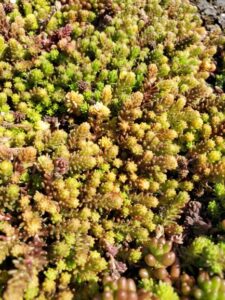 This blog is co-written by Cristina Senjug along with Dr. Karen Liu, Next Level’s green roof specialist who was present when the studio green roof was installed more than a decade ago.
This blog is co-written by Cristina Senjug along with Dr. Karen Liu, Next Level’s green roof specialist who was present when the studio green roof was installed more than a decade ago.
New Beginnings
April is around the corner. The cold winter melts away and spring brings warmer, longer, brighter days. The sedum on my extensive green roof in Toronto is waking up from a deep winter slumber (Part 1) to a new beginning. It has done a great job throughout the winter (Part 2).
Now, like our homes and gardens, green roofs can benefit from a spring cleanup.
Not sure where to begin?
Let me share some tips to get your green roof to a fresh start for the growing season ahead!

Plant Health
Remove fallen leaves and debris that has built up over the winter to allow sunlight to reach the plants. It is also a good time to remove dead branches and cut back larger perennials.
Check for winter damage. Replace plants that are damaged over winter. For sedum green roofs, spread cuttings to repair small areas and replace with new mats in large sections.
Sedum generally break dormancy around April to mid-May in Toronto, much earlier in Vancouver. It is normal for sedum to turn red/bronze in the winter and become green again in the spring.
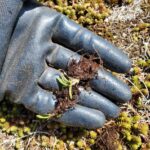
Weed Control – Nip it in the bud
Remove weeds and unwanted plants now, when they are still small. Pull out their roots entirely so they do not come back. Nipping weeds in the bud will save lots of time and effort later in the season.
Fertilizing Plan
Green roof plants will benefit from fertilizing most after the dormancy is broken when they are ready to grow. The best time to fertilize is after last frost in spring, around mid-April in Toronto.
Sedums – such as the plants on my rooftop – have minimal nutrient needs. Research at Guelph University shows that the most effective way to fertilize sedum roofs was using a Controlled Release Fertilizer (CFR) with a N:P:K ratio of 4:1:3 applied at a rate of 15 gN/m2, over 3-6 months during the active growing season.
If you have an intensive green roof with different plants they will have their unique nutrient needs. Depending on your green roof, you may want to do a soil sampling and analysis. If you do this, it is best done in the spring to detect any nutrient deficits early on and develop fertilizing regime for the growing season.
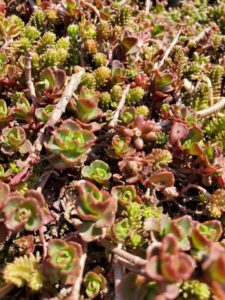 Irrigation System (if you have one)
Irrigation System (if you have one)
Spring is the time to turn on the irrigation system, if you have one, after winterization the previous year. Flush the system and check for any clogged emitters or blocked nozzles, repair any damaged drip lines or spray heads.
Ensure that the rain sensor is working, and the controller is properly programmed for each zone. Replace the backup battery with a new one.
While we do not have an irrigation system for our studio green roof, water is recommended for periods of drought. Irrigation can be in the form of an automatic irrigation system or a simple manual sprinkler system.
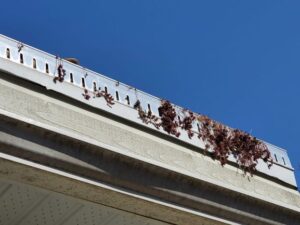
Debris and Roof Drains
Clear any debris around the roof drains to ensure good drainage. Remove overgrown plants in the vegetation free zone around the penetrations and the parapet. Check and straighten any shifted or displaced edging and replace any damaged ones.
Pay attention to rooftop microclimates such as extended shade, exhaust vents, drip edges and reflected light, and their effects on the plants. If repeated replanting proves unsuccessful, non-vegetated options such as pavers and gravel strips may be considered.
With little foliage in the way, it is a good time to visually check for signs of problems around the roof. Look around the flashing for any blister, fish mouth or excessive granule loss, which are early signs of roofing problem. Take care of any roofing issues early to avoid expensive repairs down the road.
 Photo Record
Photo Record
A photo is worth a thousand words. Photos are a great way to keep track of how a green roof evolves over the years. It helps identify anything unusual, spot when a problem first appears and evaluate if a solution is effective.
Documenting maintenance visits is an important part of the warranty. Some green roofs, such as urban agriculture, have higher maintenance needs while others such as my sedum roof, require minimal maintenance effort.
See Green Roofs Designed for Low Maintenance.
“In Spring, you should smell like dirt.”
I put on my boots and my gardening gloves. As I head over to my studio green roof to give it a spring makeover, Margaret Atwood’s words float gently in the fresh spring air, “In the spring, at the end of the day, you should smell like dirt”.

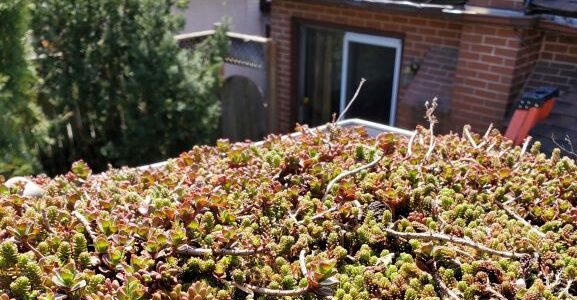
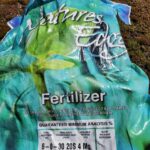
 NLSM has supplied more than 2.5 M SQFT coast to coast
NLSM has supplied more than 2.5 M SQFT coast to coast
Comments are closed.